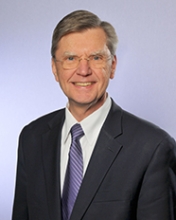ChEMS Seminar: Light-Driven Processes in Self-ordering Molecular Materials

We are also developing new materials that undergo singlet fission (SF), the spontaneous down-conversion of a singlet exciton to two triplet excitons (Figure 2), using guidance from electronic structure calculations to assure the requisite relationships between molecular singlet and triplet exciton energies. We are preparing hierarchical assemblies from these chromophores, starting from covalent dimers and trimers, then developing supramolecular assemblies, and engineered crystalline materials to investigate SF in bulk, ordered materials. We are using femtosecond transient optical spectroscopy to characterize the SF mechanism and the factors that determine its efficiency. We will present new results on the role of charge transfer states in enabling SF in molecular materials.

Biography: Professor Wasielewski received his Ph.D. in 1975 from the University of Chicago. Following his graduate work, he was a postdoctoral fellow at Columbia University. He then joined the Argonne National Laboratory, eventually becoming Group Leader of the Molecular Photonics Group. In 1994, he joined the faculty of Northwestern University, where he is currently the Clare Hamilton Hall Professor of Chemistry. He served as chair of the Department of Chemistry at Northwestern from 2001-2004. He is currently Executive Director of the Institute for Sustainability and Energy at Northwestern (ISEN), Director of the Argonne-Northwestern Solar Energy Research (ANSER) Center, which is a US-DOE Energy Frontier Research Center, and the Solar Fuels Institute, a global consortium of research centers. Professor Wasielewski's research focuses on light-driven charge generation and transport in molecules and supramolecular materials, artificial photosynthesis, molecular systems for solar fuels and electricity, molecular electronics, spin dynamics, spintronics, and time-resolved optical and EPR spectroscopy. His research has resulted in over 500 publications. Professor Wasielewski’s recent awards include the 2016 American Institute of Chemists Chemical Pioneer Award, the 2013 Royal Society of Chemistry Environment Prize, a 2013 Humboldt Research Award, the 2012 Arthur C. Cope Scholar Award of the American Chemical Society, the 2008 Porter Medal for Photochemistry, the 2006 James Flack Norris Award in Physical Organic Chemistry of the American Chemical Society, and the 2004 Photochemistry Research Award of the Inter-American Photochemical Society.
Share
Upcoming Events
-
MAE 298 SEMINAR: Technology Developments for FIR Bolometric Detector Focal Plane Assemblies
-
CBE 298 Seminar: The Wisdom of the Crowd: Watching Bacterial Collectives (Re)shape Themselves
-
CEE Seminar: BIM and the Digital Twin
-
MSE Special Seminar: Revolutionizing Battery Technology - Engineering Quantum Materials for Enhanced Safety and Performance in Solid Electrolytes
-
MSE Special Seminar: Designing Sustainable Soft Matter from the Molecule Up
